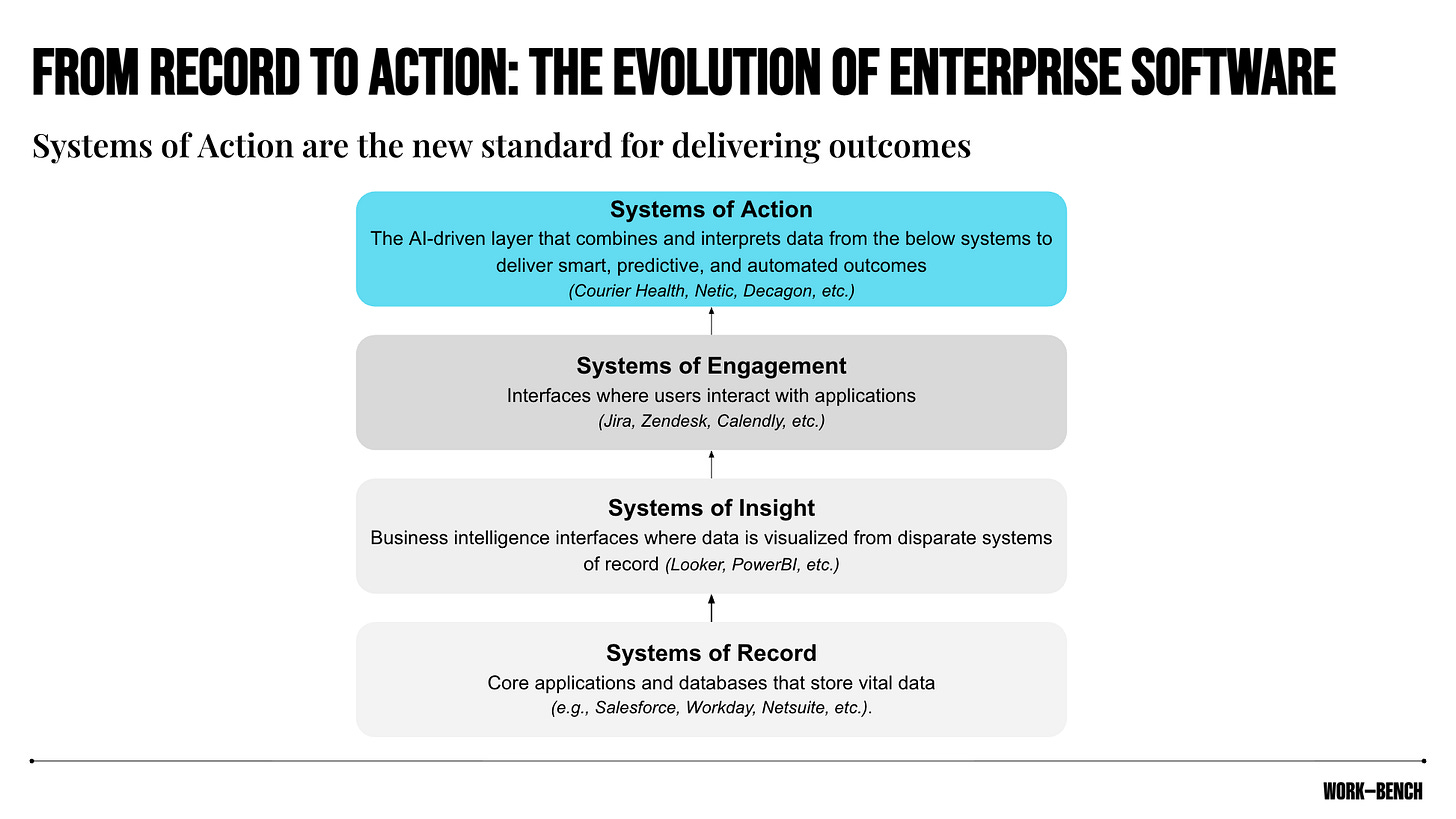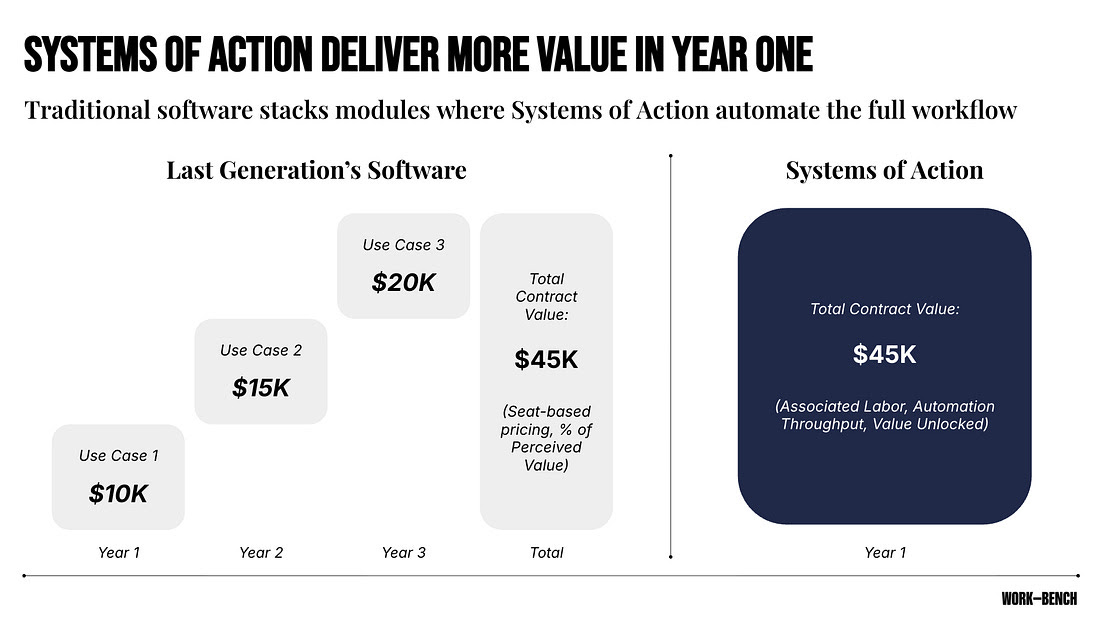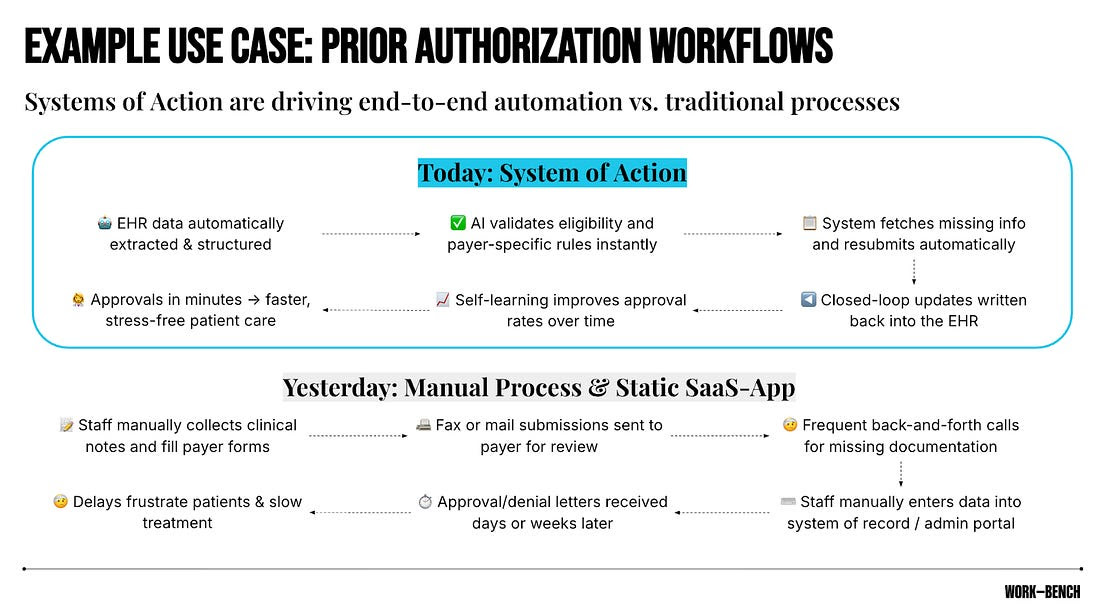In 2025, software looks radically different than it did even just a few years ago.
For years, enterprise tools were built to store information, visualize it, and help people make better decisions. Each advancement added value, but the work itself still depended on humans to connect the dots and take action.
Now, AI is changing the playing field. With its ability to reason across systems, interpret context, learn, and act, AI is transforming static workflows into dynamic, self-improving ones. The result? No more silos, just a new generation of intelligent systems (known as Systems of Action) that connect what came before and close the loop between data, decisions, and outcomes.
While AI isn’t new (and though it’s been embedded in software for years), we’re at a pivotal moment for the tech: where and how AI’s being used is changing. After years of copilots and experiments, companies are finally putting AI to work inside core business processes, where it’s beginning to make and execute decisions on its own.
Below, we break down what defines a System of Action, why it’s becoming the most defensible layer in modern software, and how this shift is opening entirely new markets.

Systems of Action: The Most Defensible Layer of Software
Systems of Action are quickly becoming the most defensible layer in modern software. They connect data across fragmented systems, interpret it in real time, and act on it, closing the loop between insight and execution.
Rather than relying on people to interpret dashboards or trigger workflows, these systems use AI reasoning and feedback to carry out decisions. Many use multi-agent systems, where specialized models handle different tasks under human oversight: One gathers data, one analyzes it, another takes action, all coordinated through a single intuitive interface
At their core, System of Action do four things:
- Understand context: Aggregate and interpret data from fragmented systems to understand what’s happening.
- Continuously evolve: Improve through human & algorithmic feedback, and become smarter and more accurate with every interaction, decision, and outcome.
- Act with autonomy: Drive towards defined goals automatically - not just recommending actions, but taking them. For example, forecasting demand and placing purchase orders without human intervention, or automatically enabling code changes in test environments.
- Embed into workflows: Integrate so deeply into day-to-day operations that switching becomes costly, creating defensibility through reliance and efficiency.
Systems of Action are powerful because they harness the compounding effects of data and AI. The more they operate, the more tailored and effective their decisions become. Unlike earlier generations of software that surfaced insights or dashboards or helped human decision-makers with an upcoming task, Systems of Action execute the end-to-end process themselves, building moats not through features but through behaviors themselves.
Where Systems of Action are Unlocking New Markets
As Systems of Action become more embedded and defensible, they’re also expanding what’s possible, and who can buy.
A defining characteristic of these systems is their ability to open markets once too narrow for venture-scale outcomes. In the last generation of software, companies had to “stack modules” or add new user seats to generate enough value to sustain growth. Systems of action flip that model: Instead of scaling through more users, they scale through more execution, turning insight into completed work.

The technical breakthroughs enabling this shift are tangible. Advances in multi-agent systems, LLM reasoning, evals, and post-training have made it possible for software to interpret context, reason across systems, and act with minimal human input. Longer memory windows allow for memory retention across steps, and machine-readable APIs and vision models expand what can be ingested and automated. Together, AI is abstracting complexity and turning once manual, multi-step workflows into intelligent software that works.

By aligning software value-to-completed work, Systems of Action are driving large contracts from historically poor software buyers right out of the gate: physician groups, 3PLs, hedge funds and underserved groups within banking, legal, energy, door-to-door sales, and more. They’re effectively targeting every inch of margin that legacy software companies have overlooked and left untouched.
Where Systems of Action Are Making Strides Today
The shift is already visible in the market and we’re seeing it play out in real time. Take our portfolio company, Courier Health (Series A, raised $24M) for example.
In biopharma, getting a patient started and staying on treatment is a huge operational challenge. Between insurance hurdles, benefit investigations, specialty pharmacy coordination, and ongoing engagement, the process is riddled with inefficiency. Roughly 30% of patients never start prescribed therapies, and up to 70% discontinue within a year.
Courier Health connects patient, provider, payer, and pharmacy data to create a unified view of each patient’s therapy journey. The platform transforms static workflows into a true “patient mission control,” showing teams exactly where each patient stands and what needs to happen next to move them forward.
By automating the manual and fragmented tasks that slow patient support teams down, Courier Health makes complex workflows efficient through AI workflows. The system automatically transcribes and summarizes calls, triggers routine actions like sending welcome emails or scheduling follow-ups, and condenses hundreds of pages of notes, emails, and documents into concise, therapy-specific overviews. These insights help teams quickly understand each patient’s status and risk factors and allow them to predict and prevent treatment drop-off, ultimately improving patient outcomes.
Beyond healthcare, we’re seeing Systems of Action drive measurable value across various sectors from demand forecasting and purchasing automation in global supply chains, to AI-driven revenue operations in the trades, to intelligent workflow orchestration in financial services, and beyond.
What’s Next & How Do We Get There?
While we haven’t yet reached the point of fully autonomous agents that operate entirely through APIs without human involvement, Systems of Action have emerged as the new standard for modern application software: intelligent, adaptive, and outcome-driven.
They represent the culmination of decades of enterprise software’s evolution from storing data, to engaging users, to now taking intelligent, scalable action. In doing so, they’ve created a new competitive advantage that we’re seeing play out in real-time.
Looking ahead, I’m exploring how companies can leverage forward deployed resources to uncover back-office inefficiencies and improve customer time-to-value, use reinforcement learning in post-training to boost agent performance, and harness synthetic and primary data to expand model utility into new markets.
For builders, this shift changes how moats are built. Defensibility now comes from systems that continuously learn from post-trained models with proprietary data and embed deeply into customer workflows.
If you’re building a System of Action or have ideas on how to get us to fully autonomous systems, I’d love to chat.
👋 I’m a principal at Work-Bench, a $160M enterprise software seed venture capital fund based in NYC. I lead pre-seed & seed rounds across AI/ML, Developer Tools, and Data-Driven Applications. I also run cofounders.nyc, a cofounder matching community. If you’re building, I’d love to chat.





